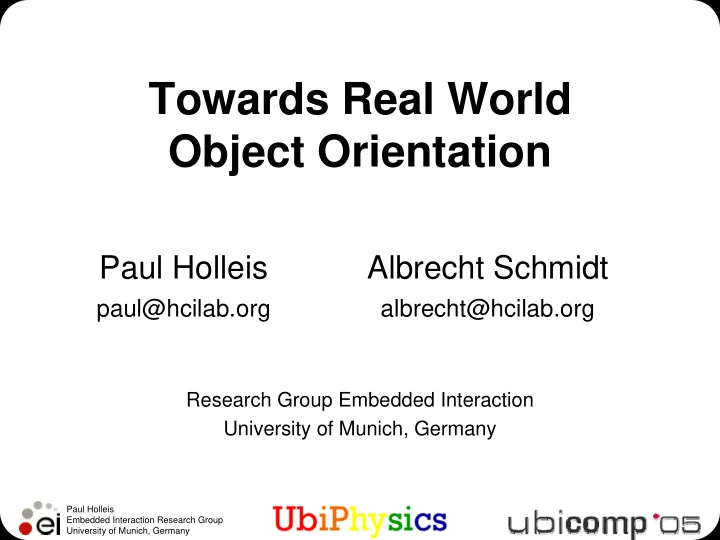

Towards Real World Object Orientation Paul Holleis Albrecht Schmidt paul@hcilab.org albrecht@hcilab.org Research Group Embedded Interaction University of Munich, Germany Paul Holleis Embedded Interaction Research Group University of Munich, Germany
“Definitions” • Real World Objects All sorts of tangible, not virtual devices Display, PDA, TV, Phone, Ball • Object Orientation See Software Engineering Objects as instances of abstractions (classes, interfaces) Properties and Capabilities Paul Holleis Embedded Interaction Research Group 2 University of Munich, Germany
Problem Statement • Many devices / technologies exist (Particles, Smart-Its, PocketPC, Symbian) • Different ways of programming for each (high level, low level, hard level) • Different communication as well • Hardly any way of combining several of them (neatly) Paul Holleis Embedded Interaction Research Group 3 University of Munich, Germany
Example Problem • Knob based on Pin&Play (N. Villar et al.) • Java programmable cell phone with display • Should be easy: Get informed on phone when knob changed – Technology is available – How to connect? Paul Holleis Embedded Interaction Research Group 4 University of Munich, Germany
Proposed Solution • Use existing programming language and environment • Treat real world objects as common programming objects • Provide the environment with capabilities to use such objects in an obvious way Paul Holleis Embedded Interaction Research Group 5 University of Munich, Germany
Example Solution Eclipse Plug-in – sense new devices – retrieve interface – create proxy classes – show and alter properties Paul Holleis Embedded Interaction Research Group 6 University of Munich, Germany
Some Open Questions? • Categorisation of devices? • Event based mechanism? • Is there an object / class hierarchy / inheritance? • What about abstraction, polymorphism? • Deploy interfaces on central server / web page associated to each device? • IDL, suitable interface description language? • Interface documentation? Paul Holleis Embedded Interaction Research Group 7 University of Munich, Germany
Recommend
More recommend